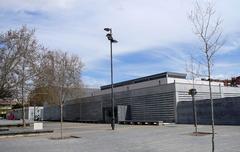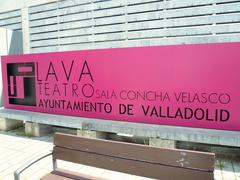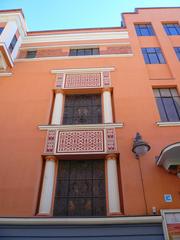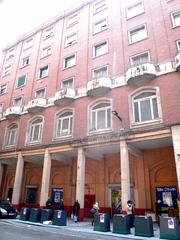
Church of San Pablo Valladolid: Visiting Hours, Tickets, and Historical Significance
Date: 04/07/2025
Introduction
Situated in the historic center of Valladolid, Spain, the Church of San Pablo (Iglesia de San Pablo) is a masterpiece that fuses religious, artistic, and political history. Famed for its striking Isabelline Gothic façade—a blend of Gothic, Plateresque, and Renaissance motifs—San Pablo is a testament to centuries of Spanish architectural innovation and spiritual devotion. The church’s foundation as a Dominican convent in the late 13th century by Doña Violante, and subsequent expansions under the direction of figures like Cardinal Juan de Torquemada and the Duke of Lerma, have secured its place as a central landmark in northern Spain. Over the centuries, San Pablo has been a stage for royal baptisms, momentous historical events, and ongoing cultural activity (inspain.org; wikipedia; lonelyplanet.com).
This guide offers essential information for visitors—from opening hours and ticketing to accessibility, nearby attractions, and travel tips—while highlighting the church’s unique artistic legacy and its significance within Spain’s cultural heritage (spain.info; cipaheritagedocumentation.org).
Table of Contents
- Origins and Foundation
- Architectural Evolution and Styles
- Historical Significance and Royal Connections
- Damage, Restoration, and Conservation
- Visitor Information: Opening Hours, Tickets, and Accessibility
- Travel Tips and Nearby Attractions
- Artistic and Cultural Legacy
- Frequently Asked Questions (FAQ)
- Key Historical Milestones
- Visuals and Media
- Conclusion & Call to Action
Origins and Foundation
The church’s roots go back to 1276, when Doña Violante, spouse of King Alfonso X, established a Dominican convent in Valladolid (inspain.org). This foundation laid the groundwork for San Pablo’s emergence as a religious and social epicenter. The current church was commissioned by Cardinal Juan de Torquemada between 1445 and 1468, during Spain’s Gothic architectural bloom (wikipedia; spottinghistory.com). Simón de Colonia, Juan Guas, and Francisco de Mora contributed to its evolving structure, culminating in a monument completed in 1616.
Architectural Evolution and Styles
San Pablo’s architecture is a tapestry of styles:
- Façade: The lower half, rebuilt in the late 15th century by Simón de Colonia, is adorned with nearly 250 sculpted figures, exemplifying Isabelline Gothic’s elaborate stonework (cipaheritagedocumentation.org). The upper façade, added in the 17th century under the Duke of Lerma, incorporates Renaissance and Plateresque elements (spain.info).
- Interior: The church features a single nave with a ribbed vault and five chapels between the buttresses (inspain.org). Artworks such as the Cristo Yacente by Gregorio Fernández stand out as Baroque masterpieces (spain.info).
Historical Significance and Royal Connections
San Pablo’s significance extends beyond art and architecture:
- It hosted the baptisms of Kings Philip II and Philip IV, symbolizing its royal status (wikipedia; spottinghistory.com).
- Its location in Plaza de San Pablo, adjacent to the Palacio de Pimentel and Palacio Real, entwined it with Spain’s monarchical and political history (1xmarketing.com).
- Napoleon Bonaparte visited during the Peninsular War, underscoring its historical prominence (wikipedia).
Damage, Restoration, and Conservation
San Pablo has weathered centuries of adversity:
- 19th Century: The Peninsular War led to significant damage; the 1835 Disentailment resulted in the destruction of much of the convent.
- 20th Century: Fires and misguided restorations further imperiled the church (cipaheritagedocumentation.org).
- 21st Century: A major restoration (2005–2010) stabilized the façade using advanced technologies and involved the public in conservation efforts (cipaheritagedocumentation.org).
Visitor Information: Opening Hours, Tickets, and Accessibility
- Opening Hours: Generally 10:00 AM–1:30 PM and 4:00 PM–7:00 PM daily. Hours may shift for holidays or events; check Horariomisas.es or official sources.
- Tickets: Admission is typically free; donations are encouraged. Special exhibitions or guided tours may require a fee.
- Guided Tours: Available by arrangement or during cultural events.
- Accessibility: The main entrance is wheelchair accessible; some areas may be challenging due to historic flooring. Contact the church for details.
Travel Tips and Nearby Attractions
- Best Time to Visit: Early morning or late afternoon for natural light and fewer crowds.
- Nearby Sites:
- Museo Nacional de Escultura: Exceptional religious art collection.
- Palacio de Pimentel: Birthplace of Philip II.
- San Benito and Santa María La Antigua Churches: Additional Gothic marvels.
- Getting There: Walk from Plaza Mayor or take public transport (bus line 3 to Plaza de San Pablo). Limited parking available; public transit is recommended.
- Facilities: No restrooms inside; available in nearby museums/cafés. No gift shop, but local vendors offer souvenirs.
Artistic and Cultural Legacy
- Façade: A visual encyclopedia of late medieval spirituality, featuring saints, biblical scenes, and heraldic emblems that reflect Dominican theology and the ambitions of aristocratic patrons (cipaheritagedocumentation.org).
- Interior: Works by Gregorio Fernández and others underscore the church’s role as a repository of sacred art (spain.info).
- Cultural Events: Semana Santa (Holy Week) processions make San Pablo a focal point for Valladolid’s spiritual and cultural life (Rough Guides).
Frequently Asked Questions (FAQ)
Q: What are the visiting hours of the Church of San Pablo?
A: Typically 10:00 AM–1:30 PM and 4:00 PM–7:00 PM daily. Confirm before visiting.
Q: Is there an entrance fee?
A: Generally free. Donations appreciated; some tours or exhibitions may charge a small fee.
Q: Are guided tours available?
A: Yes, especially during cultural events or by prior arrangement.
Q: Is the church accessible for people with mobility challenges?
A: The main entrance is accessible, though some interior areas may be difficult.
Q: Can I take photographs?
A: Non-flash photography is permitted outside of services.
Q: Can I attend Mass?
A: Yes, Mass is regularly held. See Horariomisas.es for times.
Key Historical Milestones
- 1276: Dominican convent founded by Doña Violante (inspain.org)
- 1445–1468: Current church built by Cardinal Torquemada (wikipedia)
- Late 15th c.: Façade rebuilt by Simón de Colonia (cipaheritagedocumentation.org)
- Early 17th c.: Completion under the Duke of Lerma (spain.info)
- 1808–1814: Damaged during the Peninsular War
- 1835: Convent largely destroyed
- 2005–2010: Major restoration project (cipaheritagedocumentation.org)
Visuals and Media
For an enhanced visit, explore the church’s façade and interior through virtual tours and high-resolution images available on official tourism websites.

Conclusion & Call to Action
The Church of San Pablo encapsulates the rich tapestry of Spain’s religious, political, and artistic history. Its breathtaking architecture, royal associations, and vibrant cultural life make it a must-visit landmark in Valladolid. Plan your visit with the guidance provided, attend a guided tour, and soak in the centuries-old atmosphere of this unique site.
Ready for more? Download the Audiala app for in-depth audio guides, walking tours, and up-to-date information on Valladolid’s historical and cultural hotspots. Follow us on social media for more travel inspiration and expert tips!
References
This guide is based on information from the following authoritative sources.
- inspain.org
- wikipedia
- spottinghistory.com
- cipaheritagedocumentation.org
- spain.info
- 1xmarketing.com
- Nomads Travel Guide
- ICOMS Open Archive
- Rough Guides
- Horariomisas.es
- Evendo
- The Go Guy





